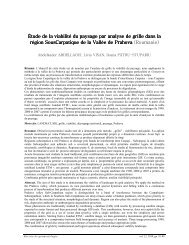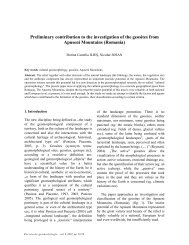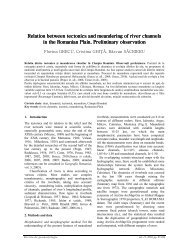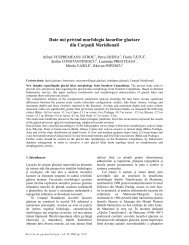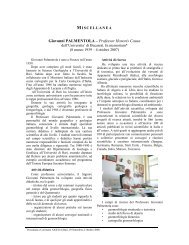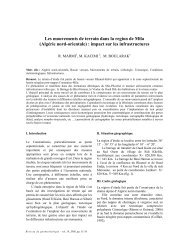Morphometrical Analysis of Microdepressions in the Central ...
Morphometrical Analysis of Microdepressions in the Central ...
Morphometrical Analysis of Microdepressions in the Central ...
You also want an ePaper? Increase the reach of your titles
YUMPU automatically turns print PDFs into web optimized ePapers that Google loves.
<strong>Morphometrical</strong> <strong>Analysis</strong> <strong>of</strong> <strong>Microdepressions</strong><br />
<strong>in</strong> <strong>the</strong> <strong>Central</strong> Baragan Pla<strong>in</strong> (Romania)<br />
Al<strong>in</strong>a GHERGHINA, Flor<strong>in</strong>a GRECU, Paola MOLIN*<br />
Key words: pla<strong>in</strong>, loess, microdepressions, morphometry.<br />
Abstarct. In <strong>the</strong> Eastern part <strong>of</strong> <strong>the</strong> Romanian Pla<strong>in</strong>, covered with loess or loess deposits, negative micr<strong>of</strong>orms<br />
(microdepressions) are develop<strong>in</strong>g, known <strong>in</strong> literature as „crovuri”, but <strong>the</strong>y also have local given names like<br />
“gavane” or ”pad<strong>in</strong>e”.<br />
From geomorphological po<strong>in</strong>t <strong>of</strong> view, ”crovurile” are depressions, (ease subsidences) <strong>in</strong> loess or loess deposits<br />
covered pla<strong>in</strong>s, hav<strong>in</strong>g circular or ellipsoidal shape, with diameters from few meters to 1-2 km, and a depth <strong>of</strong> 1-3 m.<br />
In <strong>the</strong> <strong>Central</strong> Baragan Pla<strong>in</strong> a number <strong>of</strong> 387 microdepressions with a medium density <strong>of</strong> 0.11 depr/km 2 , that covers<br />
about 5% from pla<strong>in</strong>'s surface, it has been determ<strong>in</strong>ed on topographic maps on scale <strong>of</strong> 1:50.000.<br />
Parameters like surface (S), Perimeter (P), lenght (L), width (l), have been calculated as weell as microdepression's<br />
alignment and different coefficients (<strong>in</strong>dicators <strong>of</strong> shape).<br />
The microdepressions are concentrated especially <strong>in</strong> <strong>the</strong> central-north part <strong>of</strong> <strong>the</strong> pla<strong>in</strong> with NNE-SSV and NE-SV<br />
alignment.<br />
The <strong>in</strong>vestigation shown big differences between <strong>the</strong> microdepressions from <strong>the</strong> north side (which overlaps to <strong>the</strong><br />
Holocene sands area) and those from <strong>the</strong> <strong>Central</strong> part <strong>of</strong> <strong>the</strong> pla<strong>in</strong>; <strong>the</strong> first ones have smaller dimenssions, are<br />
elongate and a bit s<strong>in</strong>ous, and <strong>the</strong> latter have bigger dimessions (surface, depth) and round s<strong>in</strong>ous shapes. Also, <strong>in</strong> <strong>the</strong><br />
Nor<strong>the</strong>rn part, <strong>the</strong> number and density <strong>of</strong> microdepressions have bigger values.<br />
Introduction<br />
In Romania, microdepressions from <strong>the</strong> loess<br />
covered regions, especially <strong>in</strong> <strong>the</strong> Romanian Pla<strong>in</strong>,<br />
are described <strong>in</strong> literature as ”crovuri”. The studies<br />
over <strong>the</strong>se relief forms are focused on two<br />
important aspects: 1) morphologically and<br />
morphometric description and 2) <strong>the</strong>ir genesis.<br />
First references on <strong>the</strong>se microdepressions <strong>in</strong><br />
<strong>the</strong> Romanian literature belongs to Murgoci which<br />
mentioned with „Câmpia Română şi Balta<br />
Dunării” paper (1907), <strong>the</strong> term ”crov” to describe<br />
<strong>the</strong> depressions on pla<strong>in</strong>'s surface ”caughted<br />
between pre-historic dunes”. In 1908, <strong>in</strong> „Raport<br />
asupra lucrărilor făcute de secţia agrogeologică în<br />
anul 1906-1907”, Murgoci says that with<strong>in</strong> <strong>the</strong><br />
central part <strong>of</strong> pla<strong>in</strong>s <strong>in</strong> Romanian Pla<strong>in</strong> emerge „<br />
vârtoape, dolii sau crovuri” whose orig<strong>in</strong> can be<br />
multiple, because <strong>of</strong>, and especially because <strong>of</strong> <strong>the</strong><br />
existence <strong>of</strong> some preloessic, as well <strong>of</strong> soil and<br />
subsoil subsidence because <strong>of</strong> water.<br />
In 1916, G. Vâlsan describes <strong>the</strong> ”crovuri”<br />
morphology <strong>in</strong> Romanian Pla<strong>in</strong> as „light<br />
depressions”, with a diameter from scores <strong>of</strong><br />
meters to 2-3 km, at a depth <strong>of</strong> 5-6 m, whose orig<strong>in</strong><br />
is <strong>the</strong> subsidence process, <strong>in</strong>fluenced by w<strong>in</strong>d.<br />
An important role <strong>in</strong> ”crovuri” studies also has<br />
Morariu who susta<strong>in</strong>ed, with<strong>in</strong> his paper, issued <strong>in</strong><br />
1945, regard<strong>in</strong>g <strong>the</strong> crovuri from Banat, that <strong>the</strong><br />
emergence <strong>of</strong> ”crovuri” can be referable to <strong>the</strong><br />
subsidence process and w<strong>in</strong>d, plus <strong>the</strong> pre-exist<strong>in</strong>g<br />
relief morphology and <strong>the</strong> <strong>in</strong>fluence <strong>of</strong> anthropic<br />
activity (Surdeanu, 2003).<br />
If morphometrical description is clear, <strong>the</strong><br />
”crovuri” genesis is still an open problem.<br />
Nowadays, we consider that <strong>the</strong>ir emergence is<br />
connected with <strong>the</strong> accumulance and dulnes <strong>of</strong><br />
water from ra<strong>in</strong>fall, salt dissolution from loess and<br />
re-sett<strong>in</strong>g <strong>of</strong> particles, hav<strong>in</strong>g as a result a smaller<br />
volume <strong>of</strong> <strong>the</strong> sediment and <strong>the</strong> issue <strong>of</strong> an<br />
perceptible subsidence <strong>of</strong> <strong>the</strong> surface.<br />
As far as <strong>the</strong> subsidence accentuates, more<br />
water gets <strong>in</strong>to <strong>in</strong>tensify<strong>in</strong>g <strong>the</strong> carbonates solution<br />
from loess, as well as material's settle and <strong>the</strong><br />
microdepression is develop<strong>in</strong>g <strong>in</strong> depth and<br />
surface.<br />
This type <strong>of</strong> microdepressions have also been<br />
identified <strong>in</strong> Europe <strong>in</strong> loess covered regions, and<br />
were named ”closed depressions”. Their genesis is<br />
Revista de geomorfo logie – vol. 10, 2008, pp. 31-38
32<br />
Al<strong>in</strong>a GH ERGHINA, Flor<strong>in</strong>a GRECU, P aola MOL IN<br />
related to natural processes (dissolution <strong>in</strong><br />
subsurface horizon) and anthropogen <strong>in</strong>terventions<br />
(digg<strong>in</strong>g).<br />
2. The study area<br />
The <strong>Central</strong> Baragan Pla<strong>in</strong> is also known as <strong>the</strong><br />
Calmatuiului Pla<strong>in</strong> or <strong>the</strong> Ialomitei Baragan,<br />
considered <strong>in</strong> geographical litterature <strong>the</strong> most<br />
untypical tabular pla<strong>in</strong>, hav<strong>in</strong>g a lacustr<strong>in</strong>e or<br />
fluvial-lacustr<strong>in</strong>e orig<strong>in</strong>.<br />
The <strong>Central</strong> Baragan Pla<strong>in</strong> is situated <strong>in</strong> <strong>the</strong><br />
south-east part <strong>of</strong> <strong>the</strong> country, <strong>in</strong> <strong>the</strong> eastern part <strong>of</strong><br />
<strong>the</strong> Eastern Romanian Pla<strong>in</strong> and it is overlapp on<br />
<strong>the</strong> Ialomita-Calmatui <strong>in</strong>terfluve.<br />
The meadows <strong>of</strong> <strong>the</strong>se two rivers represent <strong>the</strong><br />
pla<strong>in</strong>'s sou<strong>the</strong>rn and nor<strong>the</strong>rn limits. The o<strong>the</strong>r two<br />
limits are <strong>the</strong> Sarata Valley, on <strong>the</strong> western side<br />
and <strong>the</strong> Danube to <strong>the</strong> East.<br />
It has a surface <strong>of</strong> around 3370 km 2 and a light<br />
rectangular shape, with a lengt <strong>of</strong> 90 km and <strong>the</strong><br />
width <strong>of</strong> 40 km.<br />
Fig. 1 Geographical sett<strong>in</strong>g <strong>of</strong> <strong>the</strong> study area<br />
Fig. 2 Lithological cross-section (NNE-SSV) <strong>in</strong> <strong>the</strong> <strong>Central</strong> Baragan Pla<strong>in</strong><br />
From <strong>the</strong> lithological po<strong>in</strong>t <strong>of</strong> view, <strong>Central</strong><br />
Baragan Pla<strong>in</strong> is made <strong>of</strong> loess and loessoid<br />
deposits which are stay<strong>in</strong>g on clay and are covered,<br />
<strong>in</strong> <strong>the</strong> nor<strong>the</strong>rn part <strong>of</strong> <strong>the</strong> pla<strong>in</strong>, with Holocene<br />
sand deposits. The loess deposits who cover all<br />
Baragan Pla<strong>in</strong> are named ”<strong>the</strong> Baragan loess”<br />
(Grecu, Demeter, 1997) because <strong>the</strong>ir particularity:<br />
enrichment <strong>in</strong> coarser particles which caused<br />
material compactation and microdepression form<strong>in</strong>g.<br />
Accord<strong>in</strong>g to <strong>the</strong> exist<strong>in</strong>g litterature (Ana<br />
Conea, Nadia Ghitulescu, P. Vasilescu, 1963),<br />
with<strong>in</strong> <strong>the</strong> <strong>Central</strong> Baragan Pla<strong>in</strong> from <strong>the</strong> north to<br />
<strong>the</strong> south occurs <strong>the</strong> follow<strong>in</strong>g types <strong>of</strong> superficial<br />
deposits: clayey sands with <strong>in</strong>tercalated f<strong>in</strong>e and<br />
mobile sand zones, <strong>in</strong> <strong>the</strong> nor<strong>the</strong>rn part <strong>of</strong><br />
<strong>in</strong>terfluve clay-sand deposits with different<br />
percentages <strong>of</strong> rough sand, on <strong>the</strong> nor<strong>the</strong>rn half <strong>of</strong><br />
<strong>in</strong>terfluve and on <strong>the</strong> eastern part on <strong>the</strong> terrace<br />
level; silt deposits with diferent percentages <strong>of</strong><br />
coarse sand, on <strong>the</strong> sou<strong>the</strong>rn half <strong>of</strong> <strong>the</strong> pla<strong>in</strong>.<br />
The thickness <strong>of</strong> <strong>the</strong> loess deposits, grows<br />
from <strong>the</strong> west to East, from 5 to 30 meters nor<strong>the</strong>rn
<strong>Morphometrical</strong> <strong>Analysis</strong> <strong>of</strong> <strong>Microdepressions</strong> <strong>in</strong> <strong>the</strong> <strong>Central</strong> Baragan Pla<strong>in</strong> (Romania) 33<br />
from Murgeanca village, and decreases aga<strong>in</strong> to <strong>the</strong><br />
east, to 15 meters; <strong>the</strong> biggest thickness’s <strong>in</strong> <strong>the</strong><br />
Nasul Mare - Nasul Mic (20-30 m) zone, and on<br />
<strong>the</strong> <strong>in</strong>terfluve center (Căldărăşti – E Scutelnici –<br />
Colelia – Pad<strong>in</strong>a zone). Their thickness decreases<br />
to 5 meters. In <strong>the</strong> rest part <strong>of</strong> <strong>the</strong> pla<strong>in</strong> <strong>the</strong> thickess<br />
<strong>of</strong> loessoid deposits is between <strong>the</strong>se two values.<br />
The climate is cont<strong>in</strong>ental-mild with excessive<br />
<strong>in</strong>fluences with a big degree <strong>of</strong> cont<strong>in</strong>ental wea<strong>the</strong>r<br />
caracterized by: medium annual temperature with a<br />
value under 10.5 0 C <strong>in</strong> <strong>the</strong> western half (10.4 0 C at<br />
Armăşeşti) and more than this value <strong>in</strong> <strong>the</strong> eastern<br />
half (10.5 0 C at Griviţa, 10.6 0 C at Mărculeşti). The<br />
medium monthly temperatures vary from 22.4 0 C<br />
to Armăşeşti and 22.7 0 C to Griviţa for July. And<br />
between -3.1 0 C to Armăşeşti and -3.2 0 C to<br />
Griviţa for January. Medium annual ra<strong>in</strong>fall is<br />
between 450 and 500 mm (478 mm to Gr<strong>in</strong>du, 493<br />
mm to Cioch<strong>in</strong>a, 456 mm to Slobozia).<br />
The natural spontaneous vegetation <strong>of</strong> <strong>the</strong><br />
<strong>Central</strong> Baragan Pla<strong>in</strong> is specific to <strong>the</strong> steppe area,<br />
<strong>in</strong> <strong>the</strong> Eastern part and forest steppe <strong>in</strong> <strong>the</strong> Western<br />
one; The natural vegetation areas has been<br />
replaced by agricultural land.<br />
Due to <strong>the</strong> big homogenity <strong>of</strong> lithological<br />
conditions, <strong>the</strong> soil cover <strong>of</strong> <strong>the</strong> <strong>Central</strong> Baragan<br />
Pla<strong>in</strong> has a small diversification. On <strong>the</strong> <strong>in</strong>terfluve<br />
<strong>the</strong> cernozems are dom<strong>in</strong>at (calcaric, cambic,<br />
gleiyc), which make gleysols, solonchacks,<br />
solonetz associations <strong>in</strong> <strong>the</strong> central part <strong>of</strong><br />
<strong>in</strong>terfluve (where <strong>the</strong> freatic water is situated at<br />
small depths, hav<strong>in</strong>g an <strong>in</strong>fluence on soil pr<strong>of</strong>ile)<br />
and with psalmosols (on <strong>the</strong> right part <strong>of</strong> <strong>the</strong><br />
Calmatui river). In <strong>the</strong> Ialomita and Danube<br />
Floodpla<strong>in</strong> predom<strong>in</strong>ant are fluvisols (eutric,<br />
ethnic) and <strong>in</strong> Calmatui Floodpla<strong>in</strong>, solonchacks şi<br />
solonetz. The texture <strong>of</strong> <strong>the</strong> upper soil horizons is<br />
mostly loamy and clayey-loamy (<strong>in</strong> <strong>the</strong> western<br />
part, <strong>in</strong> <strong>the</strong> cambic chernozems area).<br />
3. Methodology<br />
Topographical basis started from <strong>the</strong> topographic<br />
maps on 1:50,000 scale s<strong>in</strong>ce 1970. They have<br />
been georeferencied and digitalized with Global<br />
Maper and Arcview s<strong>of</strong>tware and <strong>the</strong> graph were<br />
drawn <strong>in</strong> Word Excel.<br />
We have mesured <strong>the</strong> follow<strong>in</strong>g parameters:<br />
surface, perimeter, lenght, width, azimuth and<br />
<strong>the</strong>re were calculated more coefficients, <strong>in</strong>dicators<br />
<strong>of</strong> microdepressions shape, whose formulae are<br />
shown <strong>in</strong> table 1. The formulae for circularity and<br />
elongation <strong>in</strong>dex, that makes refference to <strong>the</strong><br />
circle shape, as well as <strong>the</strong> one <strong>of</strong> form factor,<br />
rapported to <strong>the</strong> square's form have been taken<br />
from <strong>the</strong> morphometrical analysis <strong>of</strong><br />
hydrographical bas<strong>in</strong>s. The s<strong>in</strong>uosity coefficient<br />
has been calculated as a report between <strong>the</strong> circle's<br />
perimeter that has <strong>the</strong> same surface as <strong>the</strong><br />
deprssion and <strong>the</strong> depression's perimeter, hav<strong>in</strong>g 1<br />
as a refference value, adequately to <strong>the</strong> circle<br />
shape. The non-correspondant values has been<br />
elim<strong>in</strong>ated from <strong>the</strong> analysis.<br />
Fig. 3 Lenght and width measurements<br />
Coefficient<br />
repport L/l<br />
Circularrity repport<br />
Elongation repport<br />
Shape factor<br />
S<strong>in</strong>ousity coefficient<br />
Tabel 1. Formulas <strong>of</strong> <strong>the</strong> calculated coefficients<br />
Formula<br />
R = L/l<br />
repport between <strong>the</strong> depressions lenghts <strong>of</strong> ma<strong>in</strong> axis and m<strong>in</strong>or axis<br />
Rc = Sd/Sc,<br />
repport between depressions' surface and circle's surface with <strong>the</strong> diameter equal with<br />
ma<strong>in</strong> axislenght;<br />
it is reported to value <strong>of</strong> 1, adequate to <strong>the</strong> circle.<br />
Ra = Dc/Ld,<br />
repport between circle's diameter that has <strong>the</strong> same surface as <strong>the</strong> bas<strong>in</strong> and <strong>the</strong><br />
depressions' major axis lenght;<br />
it has values between 0.67 and 1.27 for elongated depressions and more that 1.27 for<br />
<strong>the</strong> round ones.<br />
Ff = Sd/L²,<br />
repport between depressions' surface and <strong>the</strong> quadratic lenght <strong>of</strong> ma<strong>in</strong> axis, reported to<br />
<strong>the</strong> square's shape, and his guid<strong>in</strong>g mark value is 1.<br />
Ks = Pc/Pd,<br />
repport between circle's perimeter that has <strong>the</strong> same surface as <strong>the</strong> depression and<br />
depression's perimeter;<br />
reported to <strong>the</strong> circle;s shape, with guid<strong>in</strong>g mark value 1
34<br />
Al<strong>in</strong>a GH ERGHINA, Flor<strong>in</strong>a GRECU, P aola MOL IN<br />
Fig. 4 <strong>Microdepressions</strong> <strong>in</strong> <strong>the</strong> <strong>Central</strong> Baragan Pla<strong>in</strong>
<strong>Morphometrical</strong> <strong>Analysis</strong> <strong>of</strong> <strong>Microdepressions</strong> <strong>in</strong> <strong>the</strong> <strong>Central</strong> Baragan Pla<strong>in</strong> (Romania) 35<br />
4. Results<br />
The microdepressions from <strong>the</strong> <strong>Central</strong> Baragan<br />
Pla<strong>in</strong> covers a surface <strong>of</strong> 170 km 2 , (about 5% from<br />
pla<strong>in</strong>'s surface). We mapped 387 microdepressions,<br />
with a medium surface <strong>of</strong> 0.34 km 2 , with a<br />
medium density <strong>of</strong> 0.11 depr/km 2 .<br />
<strong>Microdepressions</strong> are spreaded mostly <strong>in</strong> <strong>the</strong><br />
nor<strong>the</strong>rn and central part <strong>of</strong> <strong>the</strong> pla<strong>in</strong> and on<br />
Danube terraces and have a smaller frequency <strong>in</strong><br />
<strong>the</strong> western and sou<strong>the</strong>rn outsides.<br />
Biggest densities are seen <strong>in</strong> Ulmu-Zăvoaia<br />
and Pogoanele-Căldărăşti areas, connected by<br />
holocenic sand deposits.<br />
direction and N-S (10%). These three directions<br />
hold toge<strong>the</strong>r 85% from microdepressions total<br />
(see chart 3). The smallest percentages are deta<strong>in</strong>ed<br />
by (1%), NV-SE şi ENE-VSV orientations, both<br />
with 2% şi VNV-ESE, with 3%. (fig. 5).<br />
4.1.Orientation<br />
<strong>Microdepressions</strong> predom<strong>in</strong>ant orientation is<br />
NNE-SSV (57%), followed by NE-SV (18%)<br />
Fig. 5. <strong>Microdepressions</strong> orientation<br />
Tabel 2 Medium maximum and m<strong>in</strong>imum values, <strong>of</strong> analised parameters and guid<strong>in</strong>g marks<br />
Indicator<br />
S<br />
(kmp)<br />
P<br />
(km)<br />
L<br />
(m)<br />
l<br />
(m)<br />
Rc Ra Ff Ks L/l<br />
media 0.34 2.45 935.98 384.32 0.60 0.61 0.31 0.76 2.87<br />
max 2.82 12.47 3652.31 1762.03 0.96 0.95 0.71 0.98 12.95<br />
m<strong>in</strong> 0.01 0.38 148.91 67.10 0.01 0.25 0.05 0.1 0.96<br />
4.2. Surface<br />
The average surface <strong>of</strong> microdepressions is around<br />
0.34 km 2 (table 2), with a 77% balance under <strong>the</strong><br />
medium value (microdepressions with a smaller<br />
surface, o<strong>the</strong>r than 0.5 km 2 hold a balance <strong>of</strong> 73%<br />
- see graphic 4). <strong>Microdepressions</strong> have bigger<br />
surfaces developped <strong>in</strong> <strong>the</strong> central part <strong>of</strong> <strong>the</strong> pla<strong>in</strong>,<br />
where <strong>the</strong> water is at 3-5 meter depth or under 3<br />
meters, so <strong>in</strong> most <strong>of</strong> <strong>the</strong>m <strong>in</strong> <strong>the</strong> ra<strong>in</strong>y periods <strong>the</strong><br />
water stagnates as temporary lakes. The best<br />
known and largest lakes are Tătaru, Colţea, Plaşcu,<br />
Chioibăşeşti, but <strong>the</strong>se are dry areas dur<strong>in</strong>g<br />
summer.<br />
The medium value for microdepressions<br />
perimeter is 2.45 km, frequently seen are<br />
microdepressions from <strong>the</strong> 1-5 km <strong>in</strong>terval (65%),<br />
followed by <strong>the</strong> 5-10 km <strong>in</strong>terval ones;<br />
microdepressions with <strong>the</strong> biggest values, over 10<br />
km, are rerely seen (3%). The perimeter is directly<br />
corelated with <strong>the</strong> microdepressions' surface, <strong>the</strong><br />
repport is 0.86. (fig. 7).<br />
The ma<strong>in</strong> axis lenght is about 935.98 m. The<br />
extreme values, less than 500 m and more than<br />
2000 m have a percentage <strong>of</strong> 30%, respectively <strong>of</strong><br />
10%, and <strong>the</strong> middle values, <strong>of</strong> 500-1000 m and<br />
1000-2000 m sums toge<strong>the</strong>r 60% <strong>of</strong> <strong>the</strong> total<br />
number (fig. 6). <strong>Microdepressions</strong>' lenght values<br />
are directly correlated with <strong>the</strong> surface (R = 0,86)<br />
and <strong>the</strong> width (R = 0,80) (Fig. 7).<br />
<strong>Microdepressions</strong>' width values (m<strong>in</strong>or axis<br />
lenght) is 384,32 meters, <strong>the</strong> distance 100-500 m is<br />
<strong>the</strong> most frecquent seen (70%). Extreme values<br />
under 100 m and over 1000 have 6%, respectively<br />
10% from microdepressions' total. The width<br />
varries directly and very tight with <strong>the</strong> surface, <strong>the</strong><br />
corellation report is 0,90.<br />
The depth varries between 0.30-0.60 cm, for<br />
small surface microdepressions, and 4-7 m, for<br />
bigger microdepressions, which have temporary<br />
lakes <strong>in</strong>side, such as Tataru Lake (fig. 8), Plascu<br />
Lake, Coltea Lake, Chioibasesti Lake.
36<br />
Al<strong>in</strong>a GH ERGHINA, Flor<strong>in</strong>a GRECU, P aola MOL IN<br />
a<br />
b<br />
c<br />
d<br />
Fig. 6. Ma<strong>in</strong> microdepressions' parameters: a) Surface, b)Perimeter, c) ma<strong>in</strong> axis lenght, d) m<strong>in</strong>or axis lenght<br />
a<br />
b<br />
c<br />
d<br />
Fig. 7. Correlation graphic: a) Surface -perimeter correlation; b) Lenght-width correlation; c) Surface- lenght correlation;<br />
d) Surface - width correlation
<strong>Morphometrical</strong> <strong>Analysis</strong> <strong>of</strong> <strong>Microdepressions</strong> <strong>in</strong> <strong>the</strong> <strong>Central</strong> Baragan Pla<strong>in</strong> (Romania) 37<br />
Fig. 8 Longitud<strong>in</strong>al section through Tataru Lake (NNV-SSE)<br />
4.3.<strong>Microdepressions</strong>' shape<br />
To analize microdepressions' shape <strong>the</strong>re have<br />
been calculated <strong>in</strong>dexes (table 1), reported to<br />
circles form, respectively to <strong>the</strong> value <strong>of</strong> 1. So, <strong>the</strong><br />
values close to 1 <strong>in</strong>dicates <strong>the</strong> similarity <strong>of</strong> a<br />
microdepression shape to <strong>the</strong> geometrical form that<br />
is related to (circle or square) and values close to 0<br />
<strong>in</strong>dicate an elongated shape (fig. 9).<br />
Circularity report, which refferes to circle's<br />
shape has values between 0.01 and 0.96, and 69%<br />
<strong>of</strong> microdepressions are higher than 0.5. The<br />
biggest values <strong>of</strong> circularity ratio, show,<br />
consequently, circular shapes, ang are seen <strong>in</strong><br />
small surface microdepressons' case. Small values<br />
and elongated shapes also have <strong>the</strong><br />
microdepressions situated <strong>in</strong> <strong>the</strong> nor<strong>the</strong>rn part <strong>of</strong><br />
<strong>the</strong> pla<strong>in</strong>.<br />
The elongation ratio varies between 0.25 and<br />
0.95. <strong>Microdepressions</strong> from <strong>the</strong> 0.67-1 <strong>in</strong>terval,<br />
have elongated shapes, and represents 55,4%. The<br />
rest <strong>of</strong> <strong>the</strong>m are under 0.67.<br />
The shape factor which refers to square<br />
shape, has values situated between 0.05 and 0.71,<br />
with 93,5% <strong>of</strong> values under 0.5. So, <strong>the</strong>ir shape is<br />
different from a square shape, mean<strong>in</strong>g elongated.<br />
The s<strong>in</strong>ousity coefficient, which is reported to<br />
<strong>the</strong> shape <strong>of</strong> circle too, is between 0.1 and 0.98,<br />
with a 94% percent over 0.5, which shows that<br />
microdepressions' shape is slightly s<strong>in</strong>ous.<br />
a<br />
b<br />
c<br />
d<br />
Fig. 9. Graphical representation <strong>of</strong> shape <strong>in</strong>dicators: a) circularity report; b) raportul elongation report; c) shape factor;<br />
d) s<strong>in</strong>ousity report
38<br />
Al<strong>in</strong>a GH ERGHINA, Flor<strong>in</strong>a GRECU, P aola MOL IN<br />
The lenght-width report is between 0.96-<br />
12.95, with a medium value <strong>of</strong> 2,87. 65% from <strong>the</strong><br />
cases corespond to <strong>the</strong> medium value. (Fig. 10).<br />
The biggest values correspond, generally, to <strong>the</strong><br />
<strong>in</strong>terdune microdepressions, developed on north<br />
side pla<strong>in</strong>'s holocenic sands, which are extremelly<br />
elongated.<br />
5. Conclusions<br />
Fig. 10. Lenght-width report (L/l)<br />
Both dimensions and microdepressions' shape are,<br />
mostly, determ<strong>in</strong>ated by lithological strata<br />
properties. Freatic water and w<strong>in</strong>d also <strong>in</strong>fluence<br />
<strong>the</strong>ir orientation and distribution.<br />
Most <strong>of</strong> <strong>the</strong> microdepressions are distributed <strong>in</strong><br />
<strong>the</strong> north and <strong>the</strong> central part <strong>of</strong> <strong>the</strong> pla<strong>in</strong> and have<br />
a smaller frequence <strong>in</strong> sou<strong>the</strong>rn and western sides.<br />
Biggest density are found <strong>in</strong> Ulmu-Zavoaia and<br />
Pogoanele-Căldărăşti areas, connected by<br />
Holocenic sands deposits.<br />
<strong>Microdepressions</strong>' predom<strong>in</strong>ant orientation is<br />
NNE to SSV (57%), followed by NE-SV (18%)<br />
and N-S (10%)orientations, same as predom<strong>in</strong>at<br />
w<strong>in</strong>ds.<br />
There are differences between <strong>the</strong> Nor<strong>the</strong>rn<br />
part microdepressions (superposed to <strong>the</strong><br />
Holocenic sands deposits area) and those <strong>in</strong> <strong>the</strong><br />
central part <strong>of</strong> <strong>the</strong> pla<strong>in</strong>. The first ones generally<br />
have smaller dimensions, are more elongated and<br />
less s<strong>in</strong>uous, and <strong>the</strong> latter have bigger<br />
dimenssions (surface, depth) and round shapes.<br />
Also, <strong>in</strong> <strong>the</strong> Nor<strong>the</strong>rn part, microdepressions'<br />
number and density have bigger values.<br />
Generally, microdepressions with small<br />
surfaces, under 0.05 km 2 (27%) have almost<br />
circular shapes and are not s<strong>in</strong>uous. The o<strong>the</strong>r with<br />
bigger surfaces, over 1 km 2 (16%) have complex<br />
shapes and a big degree <strong>of</strong> s<strong>in</strong>uosity. Elongated<br />
shapes, but not s<strong>in</strong>ous, features <strong>in</strong>ter dune<br />
microdepressions developed on <strong>the</strong> nor<strong>the</strong>rn side<br />
<strong>of</strong> <strong>the</strong> pla<strong>in</strong>. Their lenght/width report is bigger<br />
than 2.<br />
BIBLIOGRAPHY<br />
FLOREA, N. (1970), Campia cu crovuri, un stadiu de evolutie al campiilor loessice, Studii tehnice si economice, C, nr. 16, Studii<br />
Pedologice.Bucuresti, pp. 339-353.<br />
GRECU, FLORINA, DEMETER T., (1997), Geografia formaţiunilor superficiale, Ed. Universității, Bucureşti, 150 p..<br />
GRECU, FLORINA, PALMENTOLA, G.( 2003), Geomorfologie d<strong>in</strong>amică, Ed. Tehnică, Bucureşti, 392 p.<br />
HYATT, J.A., JACOBS, P.M, 1996, Distribution and morphology <strong>of</strong> s<strong>in</strong>kholes triggered gy flood<strong>in</strong>g follow<strong>in</strong>g Tropical Storm<br />
Alberto at Albany, Georgia, USA, Geomorphology, 17, pp.305-316.<br />
GILLIJNS, KATLEEN, POESEN, J., DECKERS J., 2004, On <strong>the</strong> characteristics and orig<strong>in</strong> <strong>of</strong> closed depressions <strong>in</strong> loess-derived<br />
soils <strong>in</strong> Europe—a case study from central Belgium, Catena, Volume 60, Issue 1, pp. 43-58.<br />
MORARIU T. (1946), Câteva consideraţiuni geomorfologice asupra crovurilor d<strong>in</strong> Banat, Revista Geografică, anul II, fasc. I-IV,<br />
1945, Bucureşti, pp. 37- 50.<br />
MORARIU T., TUFESCU V. (1964), Procese de modelare în formaţiunile loessoide d<strong>in</strong> sudul Câmpiei Române şi Dobrogea,<br />
SUBB-GG, I,Cluj, pp. 69 -84.<br />
MURGOCI GH., PROTOPOPESCU-PACHE EM., ENCULESCU P. (1908), Raport asupra lucrărilor făcute de secţia<br />
agrogeologică în anul 1906-1907, An. Inst. Geol, I, Bucureşti.<br />
TUFESCU V. (1966), Modelarea naturală a reliefului şi eroziunea accelerată, Ed. Academiei, Bucureşti, 618 p.<br />
VÂLSAN G. (1917), Influenţe climatice în morfologia Câmpiei Române, D.d.S. Inst. Geol., VII (1915-1916), Bucureşti.<br />
*** ( 2005), Geografia României, vol. V (Câmpia Română, Dunărea, Podişul Dobrogei, Litoralul românesc al Mării egre şi<br />
Platforma Cont<strong>in</strong>entală), Ed. Academiei , Bucureşti, 968 p.<br />
University <strong>of</strong> Bucharest, Faculty <strong>of</strong> Geography<br />
*University <strong>of</strong> Study Roma Tre, Department <strong>of</strong> Geology



